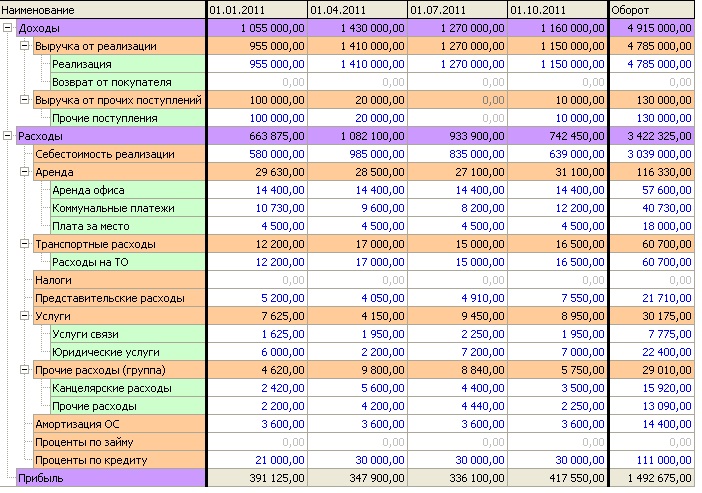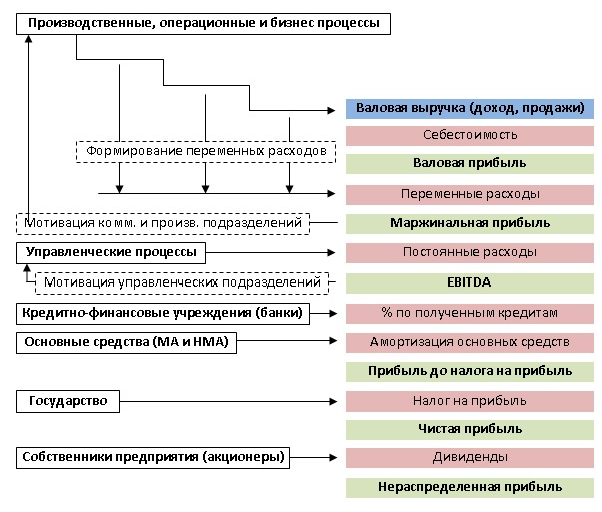In today's dynamic and competitive marketplace, effective financial management is becoming a defining factor in business success. A profit and loss statement (P&L) provides entrepreneurs and executives with the insights they need to make informed decisions aimed at improving a company's financial stability.
In the following sections of this article, we'll take a detailed look at how a profit and loss statement is constructed, the key points to consider when preparing it, and the benefits a business can gain through competent analysis and use of this financial instrument.
Example PnL report:

What is PnL?
Profit and Loss (PnL) is a measure of the difference between a business's revenues and expenses over a given period of time. The word "PnL" is often pronounced "pienel" and is a key metric for analyzing a company's financial condition, presented in the form of a profit and loss statement.
Features of the PnL report:
The PnL report covers a company's revenue for a selected period (e.g., month, quarter, year) and all associated expenses. It's important to note that both revenue and expenses, even expected ones, are recorded at the time of the transaction using the accrual method. For example, when payment for goods is deferred, sales revenue is reflected in the PnL report at the time of delivery, while expenses are recorded upon receipt of the goods, not at the time of payment.
Accounts receivable and payable in PnL:
Accounts receivable:
Accounts receivable represent the amount of money a company is entitled to receive from its customers for goods or services rendered. Including accounts receivable in the PnL report allows one to see not only actual receipts but also future expected revenues that have not yet been reflected in the company's accounts.
Example: If a company provides customers with deferred payment options, accounts receivable allow this expected income to be reflected in the PnL statement, creating a more complete financial picture.
Accounts payable:
Accounts payable, on the other hand, reflects the amounts a company is obligated to pay its suppliers for goods or services received. Including this element in PnL reflects the company's current obligations and provides information about what expenses will be recognized in future periods.
Example: If a company enters into an agreement with a supplier to pay in a few months, accounts payable allows this future expense to be factored into the PnL report, providing a more detailed understanding of the current financial situation.

Thus, including accounts receivable and payable in the P&L report not only reflects current cash flows but also provides a more transparent view of the company's long-term financial stability. This approach to financial analysis is becoming an important tool for effective management and informed strategic decision-making.
Why do you need a PnL report:
- Financial status control:
- Determining the company's income and expenses for a selected period.
- Analysis of the sales success of specific goods or services.
- Identifying profitable and unprofitable business processes.
- Identification of key expenses such as packaging, shipping, rent, advertising.
- Assessing EBITDA and EBIT to determine a company's ability to service its debt.
- Definition of net profit, which reflects the real profit of the company.
- Performance Analysis for Investors:
- Investors can evaluate the performance of a business by considering revenue, expenses, and bottom line profit.
- Investors can evaluate the performance of a business by considering revenue, expenses, and bottom line profit.
- Making informed decisions:
- Helps businesses manage their finances during payment deferrals and provides a clear picture of available funds.
- Allows you to avoid problems with cash flow gaps and make informed decisions about financial investments.

The PnL report not only provides an accurate picture of a company's financial position, but is also an essential tool for effective business management, informed decision-making and attracting investment.
How to Create a PnL Report: 9 Steps for Successful Financial Analysis
The profit and loss (PnL) statement plays a key role in assessing a company's financial health over a given period. Visually, it presents a table detailing all revenues and expenses for a month, quarter, or year, and also calculates EBITDA, EBIT, and net profit.
In large companies, this process is often automated using specialized software such as 1C:Accounting or similar programs. However, in smaller companies, PnL reporting may be done manually using spreadsheets such as Excel or Google Sheets.
Let's look at the 9 steps to creating a PnL report
- Income identification:
- Specify all income for a selected period, for example, a month.
- Cost breakdown:
- Categorize all expenses, including materials, shipping, utilities, advertising, and taxes.
- Accounting for material costs:
- Determine the cost of materials for production
- Delivery and utilities:
- Separate delivery and utility costs
- Advertising costs:
- Take into account advertising costs
- Payment of taxes:
- Determine the amount of taxes paid
- Calculation of EBITDA and EBIT:
- Calculate EBITDA (earnings before interest, taxes, depreciation and amortization) and EBIT (earnings before interest and taxes).
- Net profit:
- Determine net profit by reflecting the actual financial results of the business for the period.
- Analysis of changes:
- Assess the dynamics of changes in indicators and make decisions based on the data obtained.
By following these steps, you can effectively create a PnL report for your business and get a complete picture of its financial position.
Step 1. Revenue Recording: Revenue represents the total income a company receives from its activities, including sales of goods, work performed, and services rendered. This information is easily tracked using online cash registers or financial accounting software commonly used in businesses.
Step 2. Recording variable costs: These costs include expenses that vary with production and sales volumes, such as the purchase of raw materials, consumables, and the cost of delivering goods to customers.
In this case, variable costs include the cost of materials and delivery of finished bags and backpacks.
Step 3Gross Profit Calculation: This metric shows how much money is left over after variable expenses are subtracted from revenue.
To calculate gross profit, you need to subtract variable expenses from revenue.
Step 4Recording fixed expenses: These expenses are always present, even if the business doesn't generate revenue. These include, for example, rent, utilities, and full-time employee salaries.
In this case, fixed costs are utility costs and advertising.
Step 5. EBITDA calculation: This is a company's profit before interest on loans, taxes, and depreciation. In other words, it is operating profit.
To calculate EBITDA, you subtract fixed costs from gross profit.
Step 6. Registration of depreciation: Depreciation is a gradual reduction in the value of fixed assets and intangible assets in accordance with their wear and tear, including this process in the cost of the company's products and services.
To illustrate, to calculate depreciation expenses for, say, a vehicle, you need to divide its cost by its service life. If the cost of the vehicle is 900,000 rubles and its service life is 5 years, then the monthly depreciation amount would be 900,000 rubles / 5 years / 12 months = 15,000 rubles.
Step 7. EBIT calculation: This is a measure of profit before interest on loans and taxes. To calculate it, depreciation should be subtracted from operating profit (EBITDA).
Step 8. Recording expenses for taxes and loan interest: The amount of taxes depends on the tax system in which the business operates. In this example, the self-employed person's monthly tax bill was 4,000 rubles.
Loan interest represents the monetary amount of interest for the PnL reporting period. Let's assume a self-employed individual borrowed 100,000 rubles for one year at 10% per annum. Their payment schedule would look like this: the PnL report should include the amount for May from the "Interest Repayment" column—833.33 rubles.
Step 9. Net Profit Calculation: This is the profit after deducting all expenses, loan interest, income taxes, and depreciation. This indicator reflects how much money a business has generated over a given period. In the example provided, the self-employed individual's net profit was 23,928.67 rubles.
PnL Report Highlights: Unique Perspective and Key Points
The PnL (Profit and Loss) report, literally meaning "income and expenses," plays a vital role in analyzing a company's financial position. This document, created using the accrual method, does more than simply reflect income and expense statistics for a specific period. Its essence lies in recording data at the moment a transaction occurs, providing a more accurate picture of the company's actual financial position.
A PnL report is more than just a set of numbers; it's a powerful tool for financial control and informed business decision-making. Tracking income and expenses in real time allows business leaders to respond to changing economic conditions.
Conclusion:
Ultimately, the profit and loss statement (P&L) becomes an indispensable tool for those striving for successful business management. Careful and competent preparation of the P&L allows entrepreneurs and financial managers to delve into the depths of a company's financial performance, revealing not only the numbers but also strategic opportunities.
Assessing revenue and expenses, analyzing variable and fixed costs, and accounting for accounts receivable and payable allow you to create a complete and accurate financial picture. These tools help you identify successful trends, manage costs, and make informed business decisions.
Preparing a P&L is more than just an accounting formality; it's key to effective management, achieving financial stability, and formulating a business development strategy. Knowing how to use this tool correctly opens the door to a successful and sustainable future in business. Let the P&L become your reliable guide in realizing your entrepreneurial ambitions, helping you reach new heights and confidently meet all business challenges.







